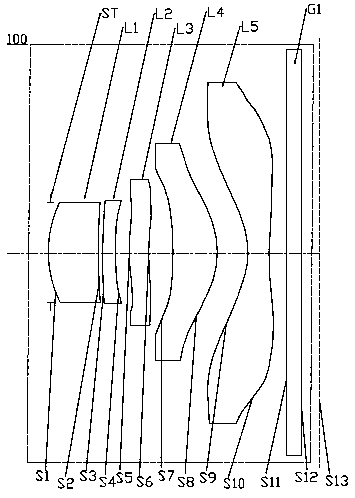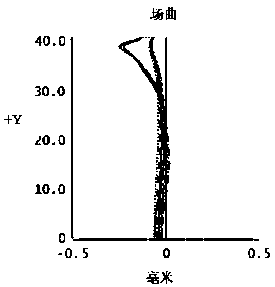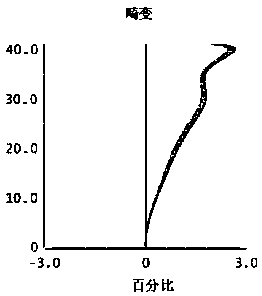Optical lens
An optical lens and lens technology, applied in the field of optical lens, can solve the problem that the screen-to-body ratio cannot be further improved, and achieve the effect of enhancing the sense of depth and space, compact structure, and good imaging quality
- Summary
- Abstract
- Description
- Claims
- Application Information
AI Technical Summary
Problems solved by technology
Method used
Image
Examples
no. 1 example
[0073] For the structural schematic diagram of the optical lens 100 provided by the first embodiment of the present invention, please refer to figure 1 , the optical lens 100 includes sequentially from the object side to the imaging surface along the optical axis: a stop ST, a first lens L1, a second lens L2, a third lens L3, a fourth lens L4, a fifth lens L5 and an infrared filter G1.
[0074] The first lens L1 is a plastic aspheric lens with positive refractive power, the object side S1 of the first lens is a convex surface, and the image side S2 of the first lens is a concave surface;
[0075] The second lens L2 is a plastic aspheric lens with negative refractive power, the object side S3 of the second lens is a convex surface, and the image side S4 of the second lens is a concave surface;
[0076] The third lens L3 is a plastic aspheric lens with positive refractive power, the object side S5 of the third lens is a convex surface, and the image side S6 of the third lens is...
no. 2 example
[0090] For the structural schematic diagram of the optical lens 200 provided in this embodiment, please refer to Figure 6 , the structure of the optical lens 200 in the present embodiment is roughly the same as that of the optical lens 100 in the first embodiment, the difference is that: the image side S2 of the first lens of the optical lens 200 in the present embodiment is a convex surface, and the second The object side surface S3 of the lens is concave, and the curvature radius and material selection of each lens are different.
[0091] The relevant parameters of each lens in the optical lens 200 provided in this embodiment are shown in Table 3.
[0092] table 3
[0093]
[0094] The surface coefficients of each aspheric surface of the optical lens 200 in this embodiment are shown in Table 4.
[0095] Table 4
[0096]
[0097]
[0098] In this embodiment, the curves of field curvature, distortion, axial point spherical aberration and lateral chromatic aberrati...
no. 3 example
[0100] For the structural schematic diagram of the optical lens 300 provided in this embodiment, please refer to Figure 11 The structure of the optical lens 300 in this embodiment is roughly the same as that of the optical lens 100 in the first embodiment, except that the radius of curvature and material selection of each lens of the optical mirror 300 in this embodiment are different.
[0101] The relevant parameters of each lens in the optical lens 300 provided in this embodiment are shown in Table 5.
[0102] table 5
[0103]
[0104]
[0105] Table 6 shows the surface coefficients of each aspheric surface of the optical lens 300 in this embodiment.
[0106] Table 6
[0107]
[0108] In this embodiment, the curves of field curvature, distortion, on-axis penalty spherical aberration and lateral chromatic aberration of the optical lens 300 are as follows Figure 12 , Figure 13 , Figure 14 and Figure 15 shown by Figure 12 to Figure 15 It can be seen that t...
PUM
 Login to View More
Login to View More Abstract
Description
Claims
Application Information
 Login to View More
Login to View More - Generate Ideas
- Intellectual Property
- Life Sciences
- Materials
- Tech Scout
- Unparalleled Data Quality
- Higher Quality Content
- 60% Fewer Hallucinations
Browse by: Latest US Patents, China's latest patents, Technical Efficacy Thesaurus, Application Domain, Technology Topic, Popular Technical Reports.
© 2025 PatSnap. All rights reserved.Legal|Privacy policy|Modern Slavery Act Transparency Statement|Sitemap|About US| Contact US: help@patsnap.com



